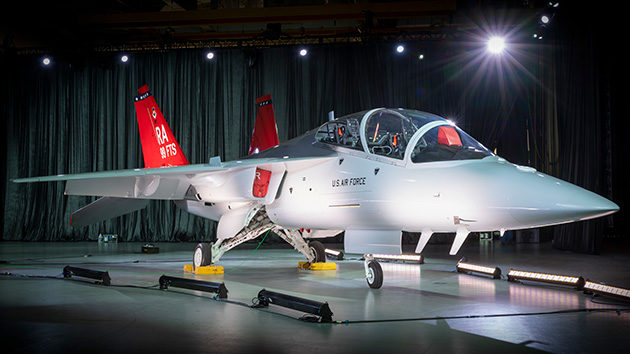The T-7A Red Hawk advanced jet trainer won’t achieve initial operational capability until early 2027, having slipped from its original goal of 2024 and a more recent timeline of 2026, Air Force acquisition executive Andrew Hunter said April 21. The delay stems from postponement of the Milestone C low-rate production decision, resulting from issues discovered in testing related to the ejection seat and more.
In an email transmitted through an Air Force spokesperson, Hunter told Air & Space Forces Magazine that “due to issues discovered in the early development and test phase of the program, the Air Force is delaying its Milestone C decision to initiate the buy of T-7A production aircraft. By extension, this will shift the T-7A program’s initial operational capability (IOC) into the spring of 2027. We are pursuing risk reduction activities to mitigate some of these schedule challenges.”
The Air Force and Boeing team completed a sled test of the ejection seat in February and are set to conduct a taxi test “within the next several weeks,” Hunter said. Those tests will hopefully provide a path to resolving the ejection seat problems, he added.
The escape system ran into trouble when testing showed that for persons at the low end of the height/weight range, ejection from the T-7 posed a risk of serious injury. Industry sources have said, however, that the manikins used to test ejection forces may have been improperly instrumented.
The T-7A program used new techniques like digital engineering and digital design to dramatically shorten the traditional time to go from initial drawings to first flight.
“As a result, we have identified and mitigated issues earlier in the development phase, prior to formal flight testing” and before a production decision, Hunter said. “This significantly reduces concurrency on the program and avoids more costly delays from discovery later in development, after a production decision.”
However, the problems discovered—including a “wing rock” issue—have pushed back the Air Force’s ambitious timeline to get the trainer in service.
The Air Force acknowledged last week the T-7A likely won’t get the green light for low-rate initial production until February 2026, but it could not at that time estimate what effect the delay would have on IOC. The production decision marked a 14-month slip from the update to the program schedule in late 2022.
The first production aircraft now will not be delivered until December 2025. Three of the five production-representative aircraft necessary for flight test are complete, and both Boeing and the Air Force anticipate formal flight testing of those airplanes will begin in the coming months.
The T-7A has also been afflicted by supply and labor shortage issues.
Boeing and USAF are “confident improvements and recent testing are yielding a safe and effective escape system,” an Air Force spokesperson said April 14.
The Air Force removed all T-7 production funds from its fiscal year 2024 budget request, saying the slip in the low-rate initial production meant production funds are not needed in the coming fiscal year.
The slip in the T-7A’s IOC date will now almost surely require the Air Force to further extend the service of some of its 60-plus-year-old T-38 advanced jet trainers, which continue to receive structural modifications and cockpit improvements.
The Air Force plans to buy 351 T-7As and has options to buy as many as 475.
In recent days, members of Congress have expressed concerns to the Air Force about trainer shortages causing delays in pilot production and deficits in pilot manning levels, particularly in fighters.
